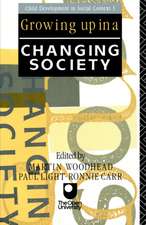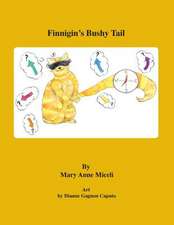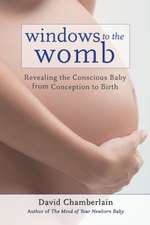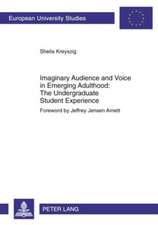What's Going on in There?: How the Brain and Mind Develop in the First Five Years of Life
Autor Lise Elioten Limba Engleză Paperback – 30 sep 2000
how a baby's brain is "assembled" from scratch
the critical prenatal factors that shapebrain development
how the birthing process itself affects the brain
which forms of stimulation are most effective at promoting cognitive development
how boys' and girls' brains develop differently
how nutrition, stress, and other physical and social factors can permanently affect a child's brain
Brilliantly blending cutting-edge science with a mother's wisdom and insight, What's Going On in There? is an invaluable contribution to the nature versus nurture debate. Children's development is determined both by the genes they are born with and the richness of their early environment. This timely and important book shows parents the innumerable ways in which they can actually help their children grow better brains.
Preț: 138.36 lei
Nou
Puncte Express: 208
Preț estimativ în valută:
26.47€ • 27.72$ • 21.91£
26.47€ • 27.72$ • 21.91£
Carte disponibilă
Livrare economică 17-31 martie
Preluare comenzi: 021 569.72.76
Specificații
ISBN-13: 9780553378252
ISBN-10: 0553378252
Pagini: 544
Dimensiuni: 156 x 233 x 27 mm
Greutate: 0.75 kg
Ediția:Bantam Trade Pb.
Editura: Bantam
ISBN-10: 0553378252
Pagini: 544
Dimensiuni: 156 x 233 x 27 mm
Greutate: 0.75 kg
Ediția:Bantam Trade Pb.
Editura: Bantam
Notă biografică
Lise Eliot is a neurobiologist and assistant professor in the Department of Cell Biology and Anatomy at the Chicago Medical School. She received her Ph.D. in neuroscience from Columbia University and has published work in this field in many professional journals. This is her first book. She lives outside Chicago with her husband and three young children.
Extras
Nature or Nurture? It's All in the Brain
Wouldn't you know it? Just as I get this beautiful, healthy neuron filled with dye and ready to image, Julia wakes up and starts crying. The experiment takes a long time to set up; I've been at it most of the day and need just ten more uninterrupted minutes. She has been so cooperative--sleeping like a baby (a nine-week-old, to be exact) in her cozy, blanket-lined computer box, safe and secure near my desk in the darkened laboratory. Finally, all the conditions are right: the microscopic neuron, vividly fluorescing down to its tiniest branches, an electrode carefully implanted to measure its electrical activity. I'm about to stimulate the cell's input pathway, to test whether it will "learn" from simulated sensory experience--when of course, Julia wakes up and wants to be fed.
What the heck. I pick her up, hike up my shirt, and start nursing, all the while twiddling dials with my free left hand. "Take off the holding current," I tell myself. "Set the extracellular voltage, configure the data acquisition, and then go!" The pulse goes out, the neuron fires a lovely train of electrical potentials, and the cell fills with calcium, color-coded, on the computer screen, with red for the most intense spots, yellow in between, and blue for the "cold" spots--distant branches that don't seem to have many pores for calcium to flow in. It's a great cell, an almost ideal experiment, until Julia suddenly pulls off my breast (curious, no doubt, about the flash of light on the computer screen) and, kicking her right foot into the delicate micromanipulator, knocks my perfect electrode right out of the perfect cell.
"No!" I wail, staring in disbelief at the computer screen. I watch as the neuron blows up into a big balloon, its membranes ripped open by the moving electrode. As it ruptures, the image on the computer screen flashes to red, then fades to orange, yellow, green, and blue as the dye dissipates. The cell is dead, a quick demise that is painful only for me.
Nobody ever said it would be easy being a mother and neuroscientist. But the juxtaposition does have its rewards at times. Here I am, trying to figure out how the neurons in a young rat's brain change with experience, and I have my own little experiment brewing right under my nose. Annoyed as I am by Julia's gymnastics, who can blame her baby brain, just trying to get some exercise for its budding motor pathways? Everything I'm trying to study in young rats is going on in her small head, a billion times over, every second of every day.
I spent ten years studying neural plasticity--the ways our brains change with experience--before Julia came along. I always knew I wanted to have children, but I had no idea how much my own research related to parenting until I actually became a mother myself. Like most new parents, I found myself suddenly fascinated by the nature/nurture issue, the degree to which Julia's future talents and weaknesses would be a product of our genes or her experience. The question is as old as humanity itself, but it is more than a mere academic debate. Whether one sides with "nature" or "nurture" makes a tremendous difference in the way we, both as parents and a society, raise our children.
Earlier in this century, the pendulum had swung fully to the "environmental" side. In a famous series of studies in the 1940s, psychiatrist Rene Spitz compared two groups of disadvantaged babies: one group was raised in what was then considered a perfectly adequate foundling home, and another group was comprised of infants whose mothers were in prison and who were being reared in a nearby nursery. Although both institutions were superficially similar--both were clean and provided the babies with adequate food, clothing, and medical care--they differed enormously in the amount of nurturing and stimulation each provided.
Babies in the prison nursery were fed, nursed, and cared for by their own mothers, who lavished enormous attention and affection on them. These children developed normally, in spite of the institutional setting and the fact that the number of hours of contact with their mothers was limited. Babies in the foundling home, by contrast, had very little stimulation; there was only one nurse for every eight infants, and except for brief feedings and diaper changes, each baby was kept isolated in his or her crib, its sides draped with sheets to prevent the spread of infection. With nothing to look at or play with and, worst of all, a bare minimum of human contact and affection, these babies suffered devastatingly. An enormous number didn't even survive to two years of age. Those who did were physically stunted, highly prone to infection, and severely retarded, both cognitively and emotionally. By three years of age, most couldn't even walk or talk, and in marked contrast to the exuberant nursery-reared children, they were strikingly withdrawn and apathetic.
Spitz's work went a long way toward changing adoption policies--eliminating the waiting periods that were at one time thought necessary to allow babies' "natural" personalities and intellectual talents to unfold. Early adoption is now universally recognized as the best option for orphans and unwanted babies, although the tragic fact is that babies in many parts of the world continue to wither in orphanages even worse than Spitz described.
Spitz showed that early nurturing and stimulation are essential to child development, and he was not alone in this view. At the time, the field of psychology was dominated by the theory of "behaviorism," which proposed that all our actions, from the simplest smile to the most sophisticated chess move, are learned through reward and punishment, trial-and-error interactions with other people and objects in the world. Babies, according to this view, are born as "blank slates," without predispositions, and infinitely malleable through parental feedback and tutoring. John Watson, the founder of modern behaviorism, even went so far as to claim:
Give me a dozen healthy infants, well-formed, and my own specified world to bring them up in and I'll guarantee to take any one at random and train him to become any kind of specialist I might select--doctor, lawyer, artist, merchant-chief, and yes even beggar-man and thief, regardless of his talents, penchants, abilities, vocations, and race of his ancestors.
No doubt Watson overstated his case, but such emphasis on early environment eventually led to the establishment of important social programs like the welfare safety net and Head Start. If children are so greatly malleable, then the best way to ensure a great society is by improving the environment of its youngest members.
These days, things have swung to the opposite extreme. We are now fully entrenched in the Era of the Gene. Every day, molecular biologists get a little closer to pinpointing which stretch of chromosome is responsible for some dreaded disease or complex behavior--alcoholism, Alzheimer's disease, breast cancer, dyslexia, sexual orientation. The government-sponsored Human Genome Project has made us heady with the potential of "decoding" the blueprint for every individual, figuring out where each of our strengths and weaknesses lies, what troubles may lie ahead, and eventually, how to cure our genetic ills. These fast-paced discoveries are exciting, to be sure, but the renewed emphasis on genes also has its discomfiting side--the tendency, fostered by books such as The Bell Curve and The Nurture Assumption, to say that parents and society make little difference. A child's fate, according to this view, is largely determined by heredity, leaving little we can do to improve matters.
As a neuroscientist, it's hard to fully accept this position. Of course, genes are important, but anyone who has ever studied nerve cells can tell you how remarkably plastic they are. The brain itself is literally molded by experience: every sight, sound, and thought leaves an imprint on specific neural circuits, modifying the way future sights, sounds, and thoughts will be registered. Brain hardware is not fixed, but living, dynamic tissue that is constantly updating itself to meet the sensory, motor, emotional, and intellectual demands at hand.
My own fascination with neural plasticity was only magnified with newborn Julia in my arms. If ever there was a time for experience to mold her brain, this was it. Although we know from studies of adult learning that the brain remains malleable throughout life, it is massively more so in infancy. Brain surgeons can even remove an entire hemisphere from the cerebral cortex of a young child (which in rare instances is the only treatment for profound epilepsy), and he or she will suffer surprisingly little loss of physical function or intellectual capacity.
I found myself wondering about every interaction: What is this caress, this diaper change, this lullaby doing to Julia's brain? Which circuits are already turned on, and which are still wiring up? What happened, at six weeks, to make her suddenly start smiling, or at eighteen weeks, so that she could finally reach out and grasp her rattle? Can Julia see those computer designs I taped up in her box? Hear the neuron firing away through the audio monitor? Know that I am her mother? Are we, her enraptured parents, in any way responsible for these wiring events, or would they have happened without any particular nurturing on our part, unfolding, like a budding flower, along a programmed trajectory that requires nothing but the most basic food, water, and air?
In other words, I needed to know: What is going on inside that little head, and what difference can I, as a parent, make in her putting it all together?
Wouldn't you know it? Just as I get this beautiful, healthy neuron filled with dye and ready to image, Julia wakes up and starts crying. The experiment takes a long time to set up; I've been at it most of the day and need just ten more uninterrupted minutes. She has been so cooperative--sleeping like a baby (a nine-week-old, to be exact) in her cozy, blanket-lined computer box, safe and secure near my desk in the darkened laboratory. Finally, all the conditions are right: the microscopic neuron, vividly fluorescing down to its tiniest branches, an electrode carefully implanted to measure its electrical activity. I'm about to stimulate the cell's input pathway, to test whether it will "learn" from simulated sensory experience--when of course, Julia wakes up and wants to be fed.
What the heck. I pick her up, hike up my shirt, and start nursing, all the while twiddling dials with my free left hand. "Take off the holding current," I tell myself. "Set the extracellular voltage, configure the data acquisition, and then go!" The pulse goes out, the neuron fires a lovely train of electrical potentials, and the cell fills with calcium, color-coded, on the computer screen, with red for the most intense spots, yellow in between, and blue for the "cold" spots--distant branches that don't seem to have many pores for calcium to flow in. It's a great cell, an almost ideal experiment, until Julia suddenly pulls off my breast (curious, no doubt, about the flash of light on the computer screen) and, kicking her right foot into the delicate micromanipulator, knocks my perfect electrode right out of the perfect cell.
"No!" I wail, staring in disbelief at the computer screen. I watch as the neuron blows up into a big balloon, its membranes ripped open by the moving electrode. As it ruptures, the image on the computer screen flashes to red, then fades to orange, yellow, green, and blue as the dye dissipates. The cell is dead, a quick demise that is painful only for me.
Nobody ever said it would be easy being a mother and neuroscientist. But the juxtaposition does have its rewards at times. Here I am, trying to figure out how the neurons in a young rat's brain change with experience, and I have my own little experiment brewing right under my nose. Annoyed as I am by Julia's gymnastics, who can blame her baby brain, just trying to get some exercise for its budding motor pathways? Everything I'm trying to study in young rats is going on in her small head, a billion times over, every second of every day.
I spent ten years studying neural plasticity--the ways our brains change with experience--before Julia came along. I always knew I wanted to have children, but I had no idea how much my own research related to parenting until I actually became a mother myself. Like most new parents, I found myself suddenly fascinated by the nature/nurture issue, the degree to which Julia's future talents and weaknesses would be a product of our genes or her experience. The question is as old as humanity itself, but it is more than a mere academic debate. Whether one sides with "nature" or "nurture" makes a tremendous difference in the way we, both as parents and a society, raise our children.
Earlier in this century, the pendulum had swung fully to the "environmental" side. In a famous series of studies in the 1940s, psychiatrist Rene Spitz compared two groups of disadvantaged babies: one group was raised in what was then considered a perfectly adequate foundling home, and another group was comprised of infants whose mothers were in prison and who were being reared in a nearby nursery. Although both institutions were superficially similar--both were clean and provided the babies with adequate food, clothing, and medical care--they differed enormously in the amount of nurturing and stimulation each provided.
Babies in the prison nursery were fed, nursed, and cared for by their own mothers, who lavished enormous attention and affection on them. These children developed normally, in spite of the institutional setting and the fact that the number of hours of contact with their mothers was limited. Babies in the foundling home, by contrast, had very little stimulation; there was only one nurse for every eight infants, and except for brief feedings and diaper changes, each baby was kept isolated in his or her crib, its sides draped with sheets to prevent the spread of infection. With nothing to look at or play with and, worst of all, a bare minimum of human contact and affection, these babies suffered devastatingly. An enormous number didn't even survive to two years of age. Those who did were physically stunted, highly prone to infection, and severely retarded, both cognitively and emotionally. By three years of age, most couldn't even walk or talk, and in marked contrast to the exuberant nursery-reared children, they were strikingly withdrawn and apathetic.
Spitz's work went a long way toward changing adoption policies--eliminating the waiting periods that were at one time thought necessary to allow babies' "natural" personalities and intellectual talents to unfold. Early adoption is now universally recognized as the best option for orphans and unwanted babies, although the tragic fact is that babies in many parts of the world continue to wither in orphanages even worse than Spitz described.
Spitz showed that early nurturing and stimulation are essential to child development, and he was not alone in this view. At the time, the field of psychology was dominated by the theory of "behaviorism," which proposed that all our actions, from the simplest smile to the most sophisticated chess move, are learned through reward and punishment, trial-and-error interactions with other people and objects in the world. Babies, according to this view, are born as "blank slates," without predispositions, and infinitely malleable through parental feedback and tutoring. John Watson, the founder of modern behaviorism, even went so far as to claim:
Give me a dozen healthy infants, well-formed, and my own specified world to bring them up in and I'll guarantee to take any one at random and train him to become any kind of specialist I might select--doctor, lawyer, artist, merchant-chief, and yes even beggar-man and thief, regardless of his talents, penchants, abilities, vocations, and race of his ancestors.
No doubt Watson overstated his case, but such emphasis on early environment eventually led to the establishment of important social programs like the welfare safety net and Head Start. If children are so greatly malleable, then the best way to ensure a great society is by improving the environment of its youngest members.
These days, things have swung to the opposite extreme. We are now fully entrenched in the Era of the Gene. Every day, molecular biologists get a little closer to pinpointing which stretch of chromosome is responsible for some dreaded disease or complex behavior--alcoholism, Alzheimer's disease, breast cancer, dyslexia, sexual orientation. The government-sponsored Human Genome Project has made us heady with the potential of "decoding" the blueprint for every individual, figuring out where each of our strengths and weaknesses lies, what troubles may lie ahead, and eventually, how to cure our genetic ills. These fast-paced discoveries are exciting, to be sure, but the renewed emphasis on genes also has its discomfiting side--the tendency, fostered by books such as The Bell Curve and The Nurture Assumption, to say that parents and society make little difference. A child's fate, according to this view, is largely determined by heredity, leaving little we can do to improve matters.
As a neuroscientist, it's hard to fully accept this position. Of course, genes are important, but anyone who has ever studied nerve cells can tell you how remarkably plastic they are. The brain itself is literally molded by experience: every sight, sound, and thought leaves an imprint on specific neural circuits, modifying the way future sights, sounds, and thoughts will be registered. Brain hardware is not fixed, but living, dynamic tissue that is constantly updating itself to meet the sensory, motor, emotional, and intellectual demands at hand.
My own fascination with neural plasticity was only magnified with newborn Julia in my arms. If ever there was a time for experience to mold her brain, this was it. Although we know from studies of adult learning that the brain remains malleable throughout life, it is massively more so in infancy. Brain surgeons can even remove an entire hemisphere from the cerebral cortex of a young child (which in rare instances is the only treatment for profound epilepsy), and he or she will suffer surprisingly little loss of physical function or intellectual capacity.
I found myself wondering about every interaction: What is this caress, this diaper change, this lullaby doing to Julia's brain? Which circuits are already turned on, and which are still wiring up? What happened, at six weeks, to make her suddenly start smiling, or at eighteen weeks, so that she could finally reach out and grasp her rattle? Can Julia see those computer designs I taped up in her box? Hear the neuron firing away through the audio monitor? Know that I am her mother? Are we, her enraptured parents, in any way responsible for these wiring events, or would they have happened without any particular nurturing on our part, unfolding, like a budding flower, along a programmed trajectory that requires nothing but the most basic food, water, and air?
In other words, I needed to know: What is going on inside that little head, and what difference can I, as a parent, make in her putting it all together?
Recenzii
"With impressive depth and clarity, Eliot...offers a comprehensive overview of current scientific knowledge about infant and early childhood brain development...Popular science at its best."
--Publishers Weekly, starred review
--Publishers Weekly, starred review
Descriere
"With impressive depth and clarity" ("Publishers Weekly"), this remarkable book offers a vivid exploration of brain development from conception through age five and shows parents and caregivers how they can enhance a child's potential.


















